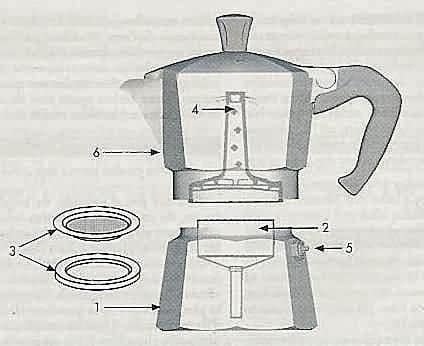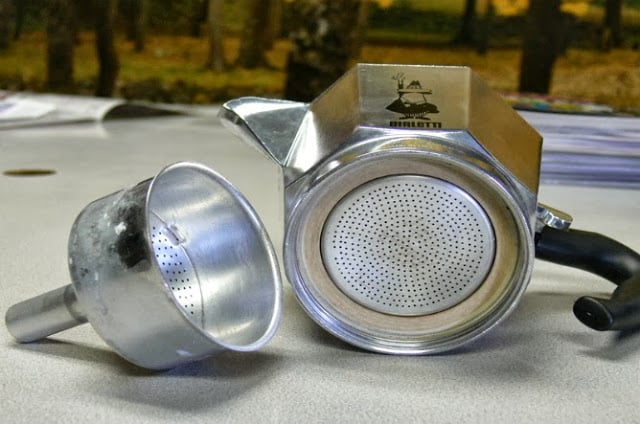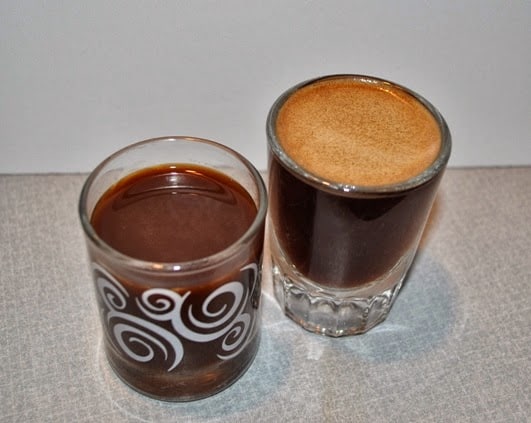I’ve been using a stovetop espresso maker for around three months now and although I know how it works I also know that I don’t REALLY know how it works so I wanted to do some digging to find out more. If you are curious how a stovetop espresso maker works then I’m sure you’ll find this a bit helpful – I sure did putting it together.
To Long Didn’t Read
For those not looking to go in depth I’ll summarize the entire post by saying this. There is a funnel that goes from the bottom of the moka pot all the way to the top. In the middle of the funnel is a basket full of coffee grind. When water turns to steam in the bottom chamber of the pot pressure builds and the water (which hasn’t yet turned to steam) is forced up through the funnel all the way to the top of the pot. Along the way the water is forced by pressure through the grind basket in the middle where it turns into moka or stovetop espresso.
How Do Moka Pots Work?
And What Is This Funnel You’re Talking About?

All stovetop espresso pots have a funnel that extends from the bottom of the lower chamber to the top of the upper chamber (see picture at right). This is where the magic happens.
The water travels through the lower part of the funnel into a wider middle zone where coffee grind sits in a basket.
The coffee grind sitting in the basket acts as an extra layer of resistance to the water (above that of gravity). This means it takes even more pressure to get the water to penetrate the grind and release into the upper chamber. As the coffee is forced through the grind it passes through another metal screen with small holes in it. This screen ensures that grind does not bubble to the top chamber although it will allow small dust – a minor bit of sediment – to make it to the top chamber and eventually to your cup. This is minimized by using a more uniform grind. The best coffee grinders will keep this to a minimum.
Lastly the filter screen is encircled by a rubber gasket which creates the water tight seal between the upper and lower chambers of the pot. This gasket is going to be replaced from time to time. If you brew your coffee in the pot on a low temperature and don’t leave it on the heat for long after the moka is finished the gasket will have a long life. If you brew on a high setting and frequently forget the pot on the burner the gasket can overheat and fail sooner than it is designed to do so. Replacement stovetop espresso maker gaskets are cheap however and somewhat easy to find online and in physical stores.

If you are making espresso then you know that a good espresso maker tends to offer adjustable pressure up to and around 15 BAR or 15 atmospheric pressures. Super automatic espresso machines can be further refined and produce espresso at different levels of pressure.
Drip coffee makers tend to fall in the 1 BAR zone meaning there is no additional pressure other than the single atmosphere pushing down on us. A high end moka pot generates a little over 2 BAR due to the added resistance of going against gravity and that of the fine grind espresso in the basket creating a minor point of resistance and an extremely small amount of crema.
Low end steam espresso makers can be found in the same price range as stovetop models. They are more complicated and have a shorter expected useful life but they tend to generate around 3 BAR pressure – just enough to start getting a small taste of coveted espresso crema and slightly more than a moka pot.
As a rule of thumb you can’t expect any significant volume of crema until you get up to around 8 BAR which is why most espresso junkies snub the moka pot or low end steam espresso makers. Even still the coffee produced by moka pots is exceptional for what it is.
 |
| Note that this espresso only has a little bit of crema. |
Below is a good example of what crema will look like coming from a high end double boiler espresso maker. Looks tasty right? 🙂
 |
| True Espresso Crema |
You can also see our growing espresso store here on Top Off My Coffee.
How A Stove Top Espresso Maker Works
This video by SeatleCoffeeGear gives a great walk-through of the standard moka pot. You can easily see all the parts as it’s disassembled and then they walk you through the brewing process.
I do find some complaint with their terminology at some points but on the whole it’s a well produced video.
You can see very clearly that espresso pots are simple devices that come apart very easily and that they all are similarly constructed.
On the whole any stovetop pot will work well but the construction process will make some units more durable than others. Cheaper units will be made from materials that may not be quite as durable. Gaskets especially can fail sooner on the low end and may be harder to replace.
More expensive stainless steel stovetop espresso makers may be more durable (and physically attractive) but they may not last any longer than bestselling units in the mid-priced zone. I tend to think that a mid-priced unit that has ample replacement parts available for sale is the best bet if you are actively shopping for a moka pot.
As for other questions on how these units work just ask your specific questions in the comments below.
There’s a lot more to learn about moka pots. Check out one of the following articles on brewing stovetop moka or espresso right now!
► How To Use A Moka Pot To Brew Coffee
► The Best Stovetop Espresso Makers
► How Long Does It Take To Brew Moka
► Stainless Steel vs Aluminum Moka Pots
► 1-Cup Stovetop Espresso Makers
► 2-Cup Stovetop Espresso Makers
► Overview & Review of the Bialetti Moka Express
► Moka Pot Cleaning Instructions
